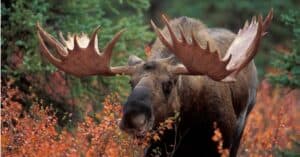Animal intelligence remains an interesting topic of discussion for biologists. With so many different species in the world, how can humans classify intelligence? And does the country of an animal change the requirements of what constitutes “smart”?
Thankfully, a widely-accepted list exists of the ways to determine animal intelligence across species that take indelible skills into account. This classification helps humans understand the cognitive abilities and behavioral patterns of animals, which in turn expands shared knowledge of the natural world.
Of all the animals in the Great White North, a few stand out as highly-intelligent species. These 12 are the smartest animals in Canada.
How to Determine the World’s Smartest Animals
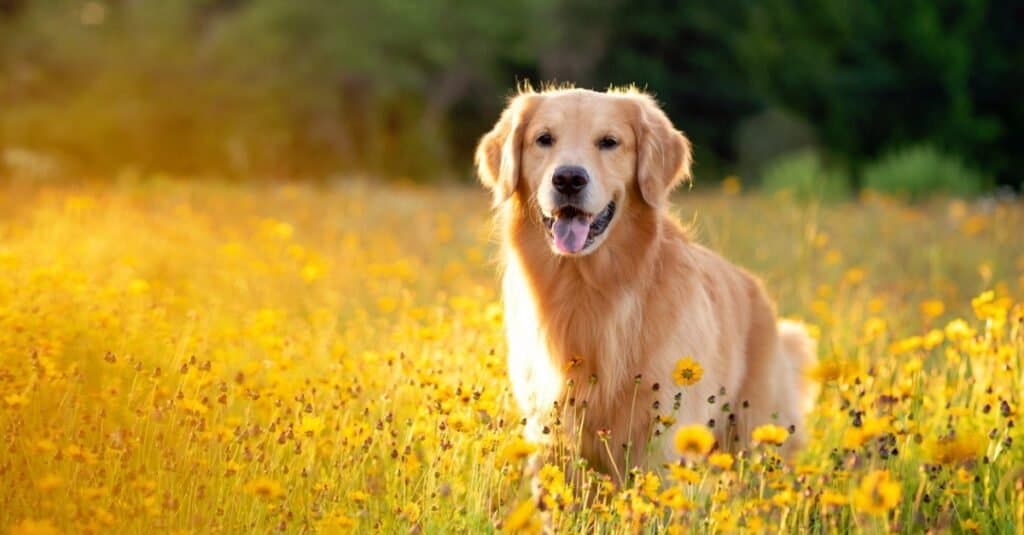
The same factors used to measure dog intelligence — including problem solving, memory, and adaptability — are used to determine the intelligence of other animals.
©Tanya Consaul Photography/Shutterstock.com
Scientists determine animals’ intelligence the same way they determine dog intelligence: through measuring cognitive abilities like problem-solving, memory, communication, use of tools, and adaptability to new situations.
Not every animal scores high in each category, which is why intelligence is a spectrum. For example, while honey bees didn’t make it onto the list of the smartest animals in Canada, they remain much more intelligent than house flies. Bees have a method of communication with their peers, know how to work for a reward, and can learn how to get the reward and teach others to do the same. House flies don’t remember things well and are notorious for poorly navigating their environment.
Canada’s 12 Smartest Animals
In no certain order, these 12 animals are the brightest thinkers in the Canadian wild.
Raccoons
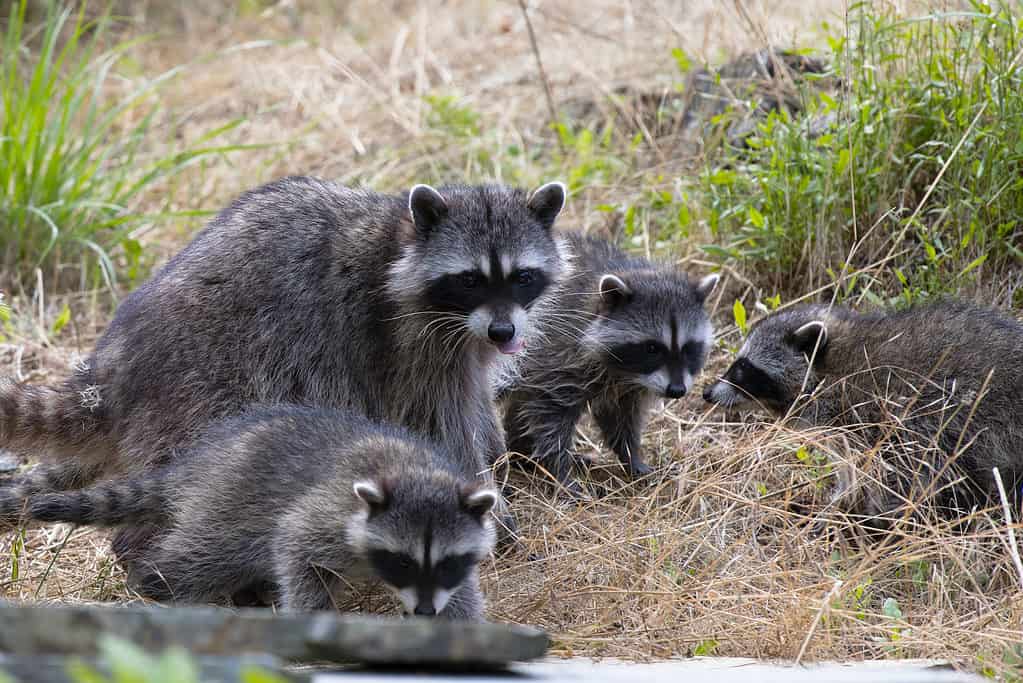
The masked bandits of Canada have incredible problem solving skills that evolve with human interaction.
©iStock.com/Wirestock
Raccoons are one of the smartest animals in Canada thanks to their neophilia. While humans and other animals alike tend to suffer from neophobia, which is the fear of new things, raccoons actually like new things and are attracted to strange things that enter their environment. Their first reaction to something new entering their space is to grab it and curiously inspect rather than run away.
Other traits and behaviors that indicate the intelligence of the raccoon include their heightened problem-solving, their attitude toward washing their food, and their adaptability.
Humans who live in places with high populations of raccoons are probably familiar with the frustrating experience of coming outside and seeing their trash rooted through, though they’ve worked to secure it from wildlife. Most likely, a raccoon solved the rudimentary puzzle of opening a lid, shoving off a weight, or overcoming a barrier. As humans find more ways to stave off raccoons from their trash, raccoon problem-solving evolves.
Raccoons also wash their food. No, it’s not to rid it of germs or dirt. It is intuitive, though. Researchers believe raccoons wash their food — especially meat or things they get from humans — to smell it better and confirm it is edible.
Lastly, raccoons can adapt nearly anywhere. As long as they have a reliable water source, raccoons can live in cold, hot, and temperate climates and in cities and forests. The only locales they avoid are tall mountain faces and deserts.
Grizzly Bears
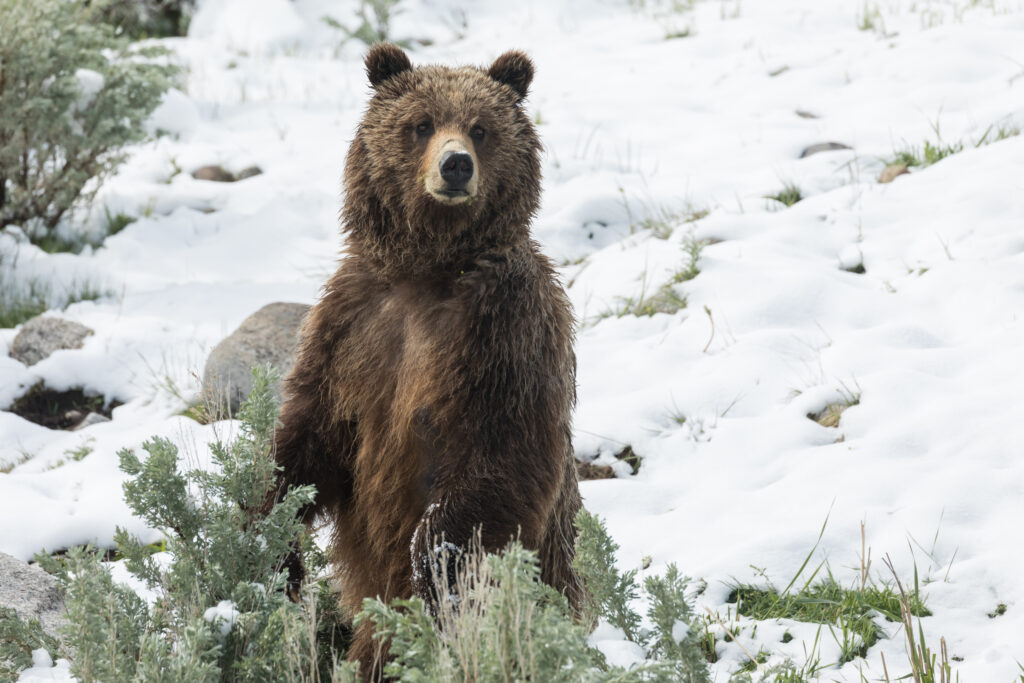
Grizzly bears know how to hunt, protect themselves and their cubs, and learn a plethora of new skills.
©Kelp Grizzly Photography/Shutterstock.com
With significant adaptability and proclivity to learn new skills, grizzly bears rank high on the list of the smartest animals in Canada.
Based on anatomy alone, a grizzly bear has a large neocortex — the part of the brain that deals with higher-order thinking. While brain size doesn’t always equate to intelligence, this situation is an outlier. Grizzlies have the situational awareness to keep themselves hidden and safe from humans, creative ways to hunt and secure food for themselves, and the ability to remember a location of food for nearly a decade.
Not only do grizzly bears have skills that make them an intelligent apex predator in the wild; captive grizzly bears have shown the range of “tricks” and knowledge that they can learn.
Have you ever seen pictures of a bear in a tutu riding a bike? That’s not fiction or exaggeration marketing for the circuses of yore — people actually trained bears to be able to ride bikes. Though incredibly unethical, it demonstrates the breadth of skill a grizzly bear can learn. Some biologists even think bears are smarter than dogs. If grizzly bears were domesticated for the same number of years as dogs, there’s no telling just how smart they’d be.
Crows
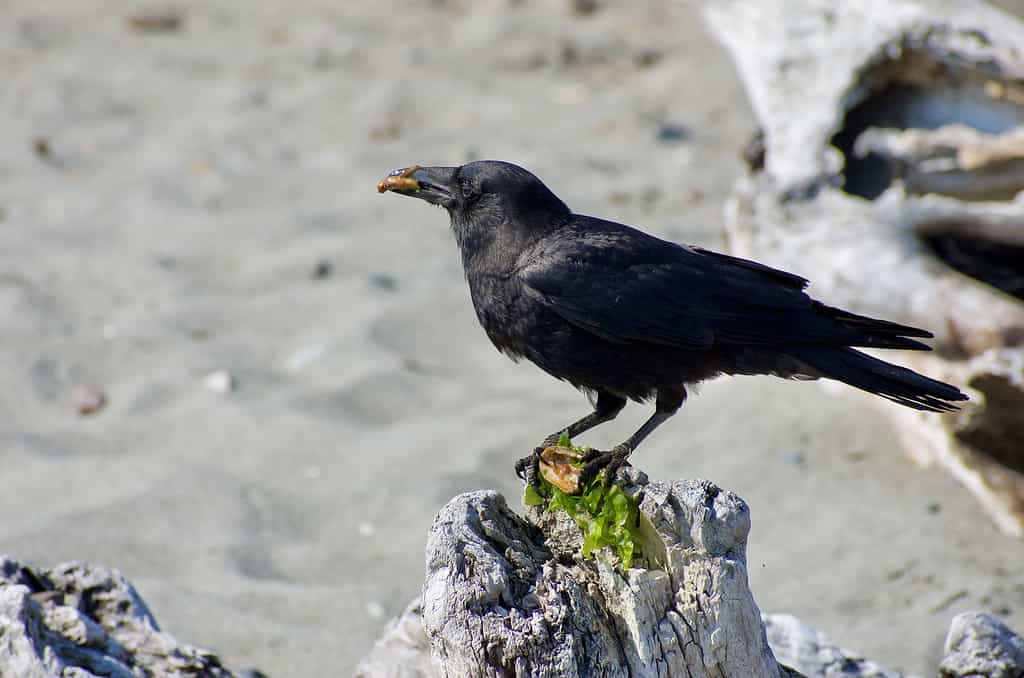
Did you know that crows have the ability to crack open and eat clams?
©iStock.com/DanielLacy
The black-as-night scavenger is one of Canada’s smartest animals for two specific reasons: its ability to communicate and problem-solve is second to only chimpanzees (which are highly regarded as the animal kingdom’s smartest animal).
Ever wonder where scarecrows came from? All the way back in ancient Japan and Greece, farmers struggled to find a way to protect their produce from crows. These birds are smart — they know where food is and will problem-solve until they secure it for themselves. Crows aren’t picky with food, either; they’ll get creative in how they hunt to ensure they can eat. That might include:
- Collecting nuts from bird feeders.
- Stealing food from outdoor dog dishes.
- Dig for clams.
- Sort through the trash.
- Feast on carrion.
Crows travel in murders, which function well as a unit. During the spring and summer, as some of the murder feeds on insects, one crow will act as a lookout to keep the feeding crows safe. This is demonstrative of how crows communicate with each other. They form close-knit bonds for nearly five generations and take care of each other by tidying the nest, hunting for food, and alerting to danger.
In addition, crows pass on knowledge from generation to generation to ensure the survival of their species. One such experiment at a school in the University of Washington had researchers trap crows while wearing a mask. After they were released from the frightening experience, the crows recognized the mask and set up alarm calls anytime they’d see someone wearing it. Over 15 years later, the crows still reacted negatively to the same mask.
Pigs

Pigs, and wild board specifically, are empathetic creatures who feel pain and build relationships.
©Budimir Jevtic/Shutterstock.com
Residents of Alberta, Manitoba, and Saskatchewan are no strangers to wild boar. What they may not know is that these lumbering, fierce predators are some of the smartest animals in their backyard.
Wild boar, and pigs in general, have a heightened intelligence thanks to their ability to problem solve, remember their surroundings, and solve complex problems.
Researchers have tested the intelligence of pigs several times in recent years, coming up with some surprising results. Not only do pigs have impressive long-term memory, but they also have emotional intelligence that allows them to show empathy for each other.
When it comes to their surroundings, pigs use what they learn to find food. Most of their learning is food motivated — like other animals — but serves them well with a tasty reward. Pigs can open boxes after months of first learning and make their way through mazes if there’s food at the center.
When it comes to community, pigs show clear distress when one of their family members is frightened or hurt. When they’re happy, they wag their tails. Pigs have even learned to take cues from each other and humans without being specifically trained.
Pigs and wild boar specifically are creatures of pattern. Once they learn a pattern, they will repeat it and expect the same result. Scientists don’t know how many patterns a board can learn, but it’s certainly a lot.
Squirrels

Squirrels have the adaptability, communication, and memory skills to survive the long Canadian winters.
©Sam Robertshaw/Shutterstock.com
As far as the rodent family, one animal reigns supreme for intelligence: the squirrel.
Similar to crows, squirrels use their intelligence to find and return to the best places to get food. Their memory spans an impressive range, demonstrated by the way they store food for themselves. Squirrels rely on burying or hiding nuts so they can return to their caches and feed during winter. Not only will they remember the location of their caches, but they can also remember the specific food sources found year after year in different regions or locales. Furthermore, squirrels pick the locations of their cache to be easily accessible in winter, when their energy is low and they need a quick bite to refuel.
Because squirrels are so good at sniffing out caches, each squirrel will bury their nuts over and over again. Squirrels will even go so far as pretending to bury a nut if they know they’re being watched by a predator, like birds or humans, or a peer. When discovered, this realization was groundbreaking — that sort of tactical deception was only thought to be found in primates.
Finally, squirrels communicate with each other through tail twitches and squeaks to indicate food sources, threats, and attempts to mate.
Rats
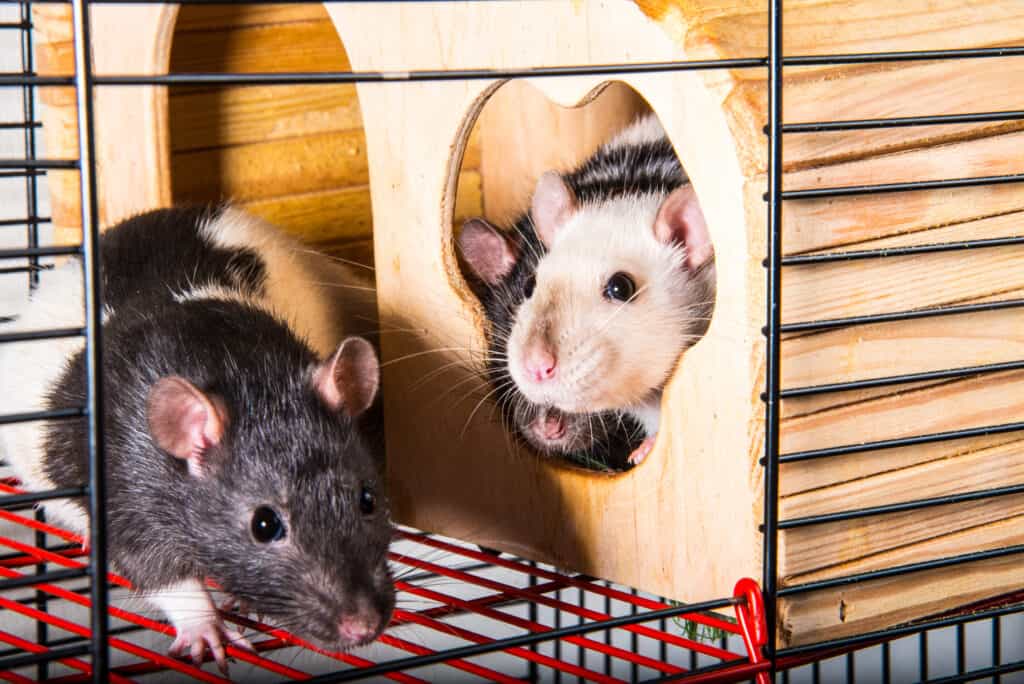
Rats have demonstrated their intellect and empathy in recent years as a popular pet.
©Liukov/Shutterstock.com
Also part of the rodent family, rats have a high intellect — especially considering how small they are. After all, there’s a reason why scientists use them to test theories and coined the term “lab rats,” right?
Rats remain wonderful students that can learn and understand both simple and complex concepts. They also have great memories. Both of these skills help them in finding food. The clearest example of a rat’s combined skills of memory and learning is how they solve a maze to get to the food in the middle. Once they’ve solved the puzzle, they have memorized the route and can complete it again and again.
Another portion of the rat’s brain that indicates how intelligent they are is their sociability. Remember, intelligence includes communication, and rats are very sociable. They bond quickly with mates, family, and even human companions. In fact, though they’ve been domesticated for decades, pet rats have grown in popularity over the last five years.
Rats use a series of high-frequency vocalizations to communicate with each other about different things like food, potential dangers, and even their feelings. Because they have a complex system of communication, it includes both sounds, smell, and touch. Researchers have also observed play between rats, including singing and wrestling, that demonstrates how integral companionship is to the well-being of the species.
Foxes

Foxes actively problem-solve to avoid humans and other predators while scavenging in urban areas for food.
©Ondrej Prosicky/Shutterstock.com
Considered clever as far back as Native American written stories and ancient civilizations, foxes have outperformed dogs as far as intelligence in almost every category. These tactical, emotional creatures rank among Canada’s smartest animals because of their proclivity to protect, outwit, and hunt.
As far as hunting goes, foxes are sly. They don’t like humans usually but have found a way to coexist in secret to secure the food left out in trash cans. They’ll also hide the excess food they find like a squirrel does to come back later when they’re hungry.
Similarly, they do this with their dens. With underground dens, foxes can hide their kits and themselves from predators while keeping cool in the summer heat.
The illustrations of clever foxes being the “bad guy” might not be too far off. Scientists have observed foxes finding mice to simply play with — they’ll catch the mouse and follow it, not eating it and only letting it go when it’s bored of the game.
Pigeons

Pigeons remain one of the only animals to pass a mirror test.
©iStock.com/Nikolay Chekalin
Though pigeons get a bad rap for being “stupid” animals based on their appearance, these birds have an incredibly complex mind. So much so, they’re one of the only species capable of passing the “mirror test,” or an experiment that tests self-awareness. While not the best at solving problems, their memory and sociability are worthy of note.
Pigeons have an astoundingly good ability to navigate with their internal compass and the sun’s positioning. Their nuanced memory comes into play during navigation as well; researchers have found that pigeons use landmarks and man-made structures to orient themselves to their surroundings and track their progress in a journey. They can also learn compounded patterns and repeat them on command with little repetition of training in between.
Finally, pigeons mate for life and take a vested interest in raising young together with their partner.
Orcas

Did you know that orcas have different levels of friendships with the members of their pods?
©slava296/Shutterstock.com
Orcas are remarkable creatures with a plethora of different intelligence factors.
Though they frequent very different habitats, orcas have an intelligence that is said to rival chimpanzees and gorillas. They have all the makings of a smart animal — including the ability to creatively problem solve, communicate in a complex nature with their pod or other orcas, and remember locations and actions.
Even without arms and fingers, orcas can use tools to augment their environment and solve problems. Some researchers have observed orcas using waves they make themselves to wash prey off of ice floes and into the water, where they can consume them.
When it comes to community communication, orcas use echolocation and listening to other orcas speak to learn the location of food, become wary of danger, and even imitate each other. In addition, the echolocation used between orcas helps each individual whale create a mental picture of the world around them, even if they aren’t in the same region. As long as they can hear the whistles and clicks, an orca begins to use its brain’s processing power to create a mental map.
In addition, orcas have a complex relationship with each other and their emotions. Orcas can feel — and often demonstrate — grief at the loss of a close family member. They have also acted in such a way as to suggest they have different levels of friendships with individual whales in their pods.
Wolverines
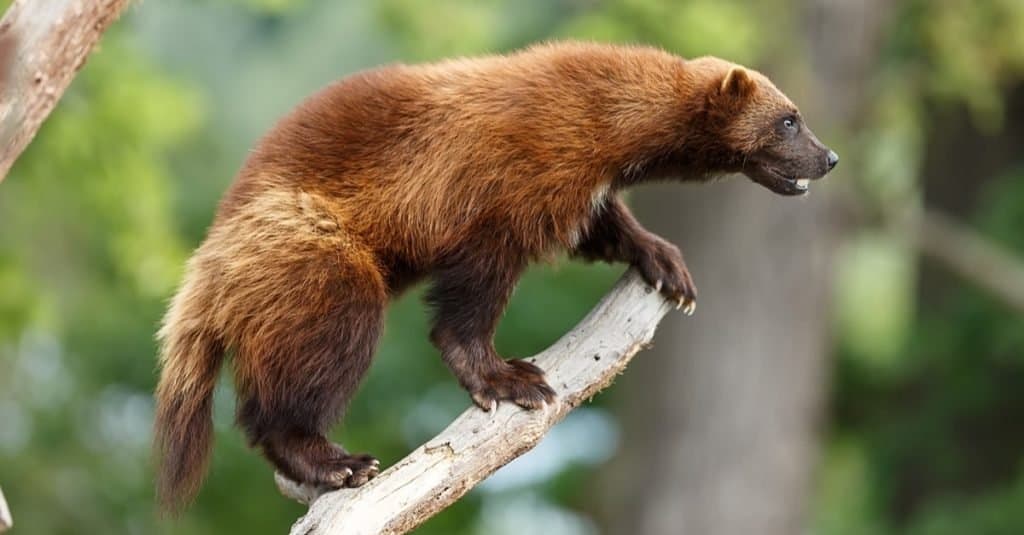
Wolverines will travel dozens of miles in new territory to track and hunt prey before relying on their intelligence to guide themselves home.
©Michal Ninger/Shutterstock.com
This pint-sized weasel has a reputation for being twice as fierce as a grizzly bear and bloodthirsty in any situation. A lot can be said about their attitude — but no one talks about their intelligence.
Wolverines possess an uncanny ability to survive in the wild. This adaptability alone makes them highly-intelligent creatures. They have the proclivity to survive in extreme temperatures; specifically, the alpine environments of Canada’s most northern territories.
Building off of their adaptability, wolverines have a curious nature and opportunistic way of hunting. Unlike grizzly bears, which tend to stay in their home range of hunting, wolverines will travel an impressive 30 to 40 miles a day to hunt prey. Their memory serves them well, guiding them back to their home from miles away after a long hunt.
Furthermore, wolverines are clever and resourceful, relying on their sharp and creative problem-solving skills to get themselves out of tough situations with predators, using human roads to cut down their travel time between destinations, and even sneak bait out of traps.
Though not as social as some of the other animals on the list, scientists have recorded wolverines playing with toys and interacting with others in their species for fun.
Beluga Whales

Like orcas, beluga whales are social creatures with emotional intelligence, empathy, and adaptability.
©Luna Vandoorne/Shutterstock.com
The white, funny-foreheaded whale of the north is a naturally curious and social animal with surprisingly high intelligence.
Scientists consider beluga whales one of the most intelligent creatures on earth based on their communication methods, ability to problem solve creatively, and proclivity to learn and remember new things.
A surprising discovery found that beluga whales are vocal, or auditory learners, just like humans. When a song was played for a beluga whale outside of its tank and the whale began to bop its head to the tune, scientists realized not only could the whale hear it, it understood and could follow the beat.
Like crows, beluga whales pass knowledge down through their generations. Known as learned cultural traditions, this includes how to avoid predators in the wild and specific migration patterns.
Beluga whales are curious about their environment, often exploring for fun and using it as a learning experience to pass down to future generations. Like rats, beluga whales thrive when they’re with others in a pod and even blow bubbles to entertain themselves and others.
As mentioned with grizzly bears, a larger brain does not equate to more intelligence. The beluga whale’s brain is large — about 4.5 pounds — but that does not dictate the actual factors of intelligence. How beluga whale interacts with themselves, their peers, and the world around them are the most indicative signals of intelligence.
Gray Wolves

The complex social structure of wolf packs provides the best demonstration of a gray wolf’s communication style.
©Szczepan Klejbuk/Shutterstock.com
Last, but certainly not least on the list of the smartest animals in Canada, the gray wolf remains one of the most intelligent creatures in the wilderness — even more so than its domesticated cousin. Based on their resourcefulness, adaptability, and social structure, gray wolves have impressively-high intelligence.
The largest knock against the gray wolf is how little it cares about humans, making it exceptionally hard to measure just how skilled they are. In captivity, gray wolves don’t care about completing tasks or learning tricks. Of course, humans respect their wishes — but it makes research difficult when attempting to measure the animal’s proclivity to solve problems creatively.
In the little research done, biologists have discovered several indications that the gray wolf is smarter than domesticated dogs and many other animals in its ecosystem:
- Gray wolves understand the link between cause and effect.
- They hunt and live in packs, which demonstrates their ability to communicate and cooperate.
- They study their prey before attacking, learning behaviors and remembering the best way to take it down.
- They will coordinate with other wolves to bring large prey down.
Overall, the gray wolf’s intelligence is in a class of its own. These nuanced creatures show a deep understanding of their environment, how to hunt, and the best way to ensure their and their pack’s survival.
Canada’s Smartest Class
The creatures that make up Canada’s smartest animals range between mammals, birds, and marine life. With each species, a different — but equally impressive — type of intelligence surfaces, teaching humans just how impressive the animal world is. By showing respect where it is due and continuing to observe these intelligent creatures, we can learn just how skilled those we share our backyard with are.
Thank you for reading! Have some feedback for us? Contact the AZ Animals editorial team.





